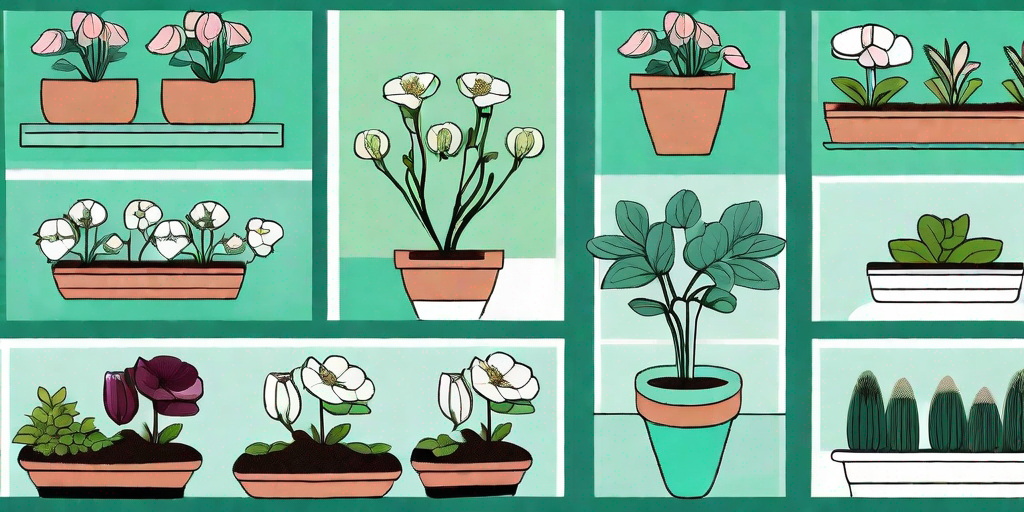
Hellebores, also known as the winter roses, are the unsung heroes of the late winter and early spring garden. These hardy perennials are not only beautiful but also incredibly easy to grow and maintain. But, like all plants, they need a little TLC when it comes to transplanting. This guide will take you through the process step by step, with a dash of humor and a pinch of cheekiness thrown in for good measure.
The Hellebore: A Brief Introduction
Before we dive into the nitty-gritty of transplanting, let's take a moment to appreciate the hellebore. This plant is a true gem in the garden, blooming when most other plants are still in their winter slumber. Hellebores come in a variety of colors, from pure white to deep purple, and their flowers have a delicate, almost translucent quality that is truly enchanting.
But hellebores are not just pretty faces. They are also tough as nails, able to withstand freezing temperatures and thrive in shady conditions where other plants struggle. This makes them an excellent choice for those tricky spots in your garden that don't get much sun.
When and Why to Transplant Hellebores
So, when should you transplant your hellebores? Well, like many things in life, timing is everything. The best time to transplant hellebores is in the fall, after they have finished blooming but before the ground has frozen. This gives the plants plenty of time to establish their roots in their new location before the cold winter months set in.
But why would you want to transplant your hellebores in the first place? There are a few reasons. Perhaps you've noticed that your hellebores are getting a little crowded in their current location, or maybe you've decided to redesign your garden and want to move your hellebores to a new spot. Whatever the reason, transplanting hellebores is a relatively straightforward process, as long as you follow a few key steps.
How to Transplant Hellebores: A Step-by-Step Guide
Step 1: Choose the Right Spot
First things first, you need to choose the right spot for your hellebores. These plants prefer shady locations, so look for a spot in your garden that gets plenty of shade, especially in the afternoon. The soil should be well-draining and rich in organic matter. If your soil is heavy clay, you may want to amend it with some compost or well-rotted manure to improve its texture and fertility.
Step 2: Dig the Hole
Once you've chosen the perfect spot, it's time to dig the hole. The hole should be twice as wide and just as deep as the root ball of your hellebore. This gives the roots plenty of room to spread out and establish themselves in their new home.
Step 3: Remove the Hellebore from Its Current Location
Now comes the tricky part: removing the hellebore from its current location. Use a garden fork to gently loosen the soil around the plant, then carefully lift it out of the ground, making sure to keep as much of the root ball intact as possible.
Step 4: Place the Hellebore in the Hole
Place the hellebore in the hole, making sure that the top of the root ball is level with the surrounding soil. Backfill the hole with soil, firming it gently around the base of the plant.
Step 5: Water Well
After transplanting, water your hellebore well. This helps to settle the soil around the roots and reduces transplant shock. Continue to water regularly until the plant is established.
Post-Transplant Care
After transplanting, your hellebores will need a little extra care to help them settle into their new home. Keep the soil consistently moist, but not waterlogged. Apply a layer of mulch around the base of the plant to conserve moisture and suppress weeds. If you notice any wilted or yellowing leaves, remove them to prevent the spread of disease.
With a little patience and care, your transplanted hellebores should soon start to thrive in their new location. And come late winter, when their beautiful blooms start to appear, you'll know that all your hard work was worth it.
FAQs
Can I transplant hellebores in the spring?
While it's possible to transplant hellebores in the spring, it's not ideal. The plants are usually in full bloom at this time, and moving them can cause the flowers to wilt. If you must transplant in the spring, do so early in the season before the plants start to bloom.
How often should I water my transplanted hellebores?
Water your transplanted hellebores regularly, keeping the soil consistently moist but not waterlogged. A good rule of thumb is to water deeply once a week, but this may vary depending on your soil type and the weather conditions.
What should I do if my transplanted hellebores don't bloom?
If your transplanted hellebores don't bloom, don't panic. It's normal for plants to take a year or two to settle in after being moved. Keep caring for your hellebores as usual, and with a little patience, they should start to bloom in time.
Conclusion
Transplanting hellebores may seem like a daunting task, but with a little preparation and care, it can be a rewarding experience. So, roll up your sleeves, grab your garden fork, and get ready to give your hellebores a new lease on life. Happy gardening!















